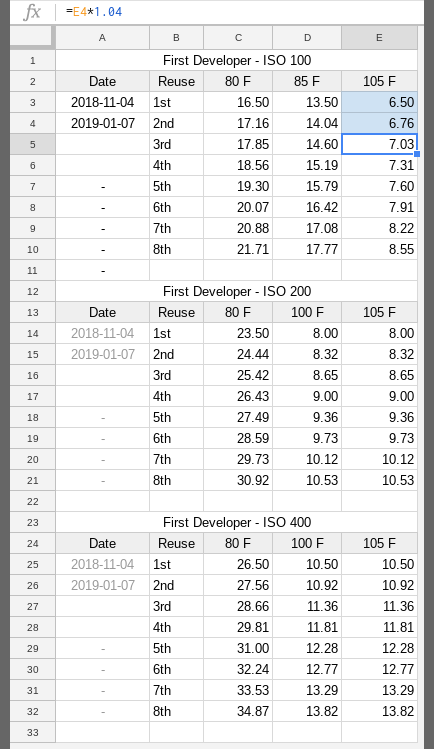Color Reversal Development
Every time I pull film that I developed out of a canister I marvel that such a complex process could suceed.
Metering for color reversal film is a two stage process: first for exposure, second for development. If you are shooting an entire roll under controlled lighting conditions, you don't need to nail the exposure. If you are within the film's latitude and have some accurate lighting readings you can set the final speed by push processing.
How Does it Work?
Technical information on the web on how color reversal development works is very thin. Roughly the following is happening
- The first developer is a black and white developer that converts the latent image in each emulsion layer to metallic silver. The color positive image is formed in the undeveloped areas.
- In the reversal stage the film is chemically "fogged", which exposes the silver halides in the areas not developed in the first developer. The film is still completely black because the dyes are shielded by the developed silver.
- The color developer changes the fogged silver halides to black metallic silver and the CMY dye couplers are formed by the oxodized developer.
- The prebleach stage stabilizes the dye layers.
- The bleach converts metallic silver into a form that can be fixed.
- The fixer converts silver halides to a water soluble form.
Stages 3 and 4 work in the exact same manner as color negative processing.
Temperature
From what others have written, it seemed that color reversal was difficult because color processes require careful temperature control. You do need a thermometer and a way to get the chemistry up to temperature, but the process is far more forgiving than some might lead you to believe.
The Arista formula that I use is optimal at 105°F or 100°F. I fill a 12x10x7" insulated foam shipping container with hot water that is about 115°F, put the bottles in and wait for it to cool down a bit. It's that simple!
Reels
I started out with plastic reels, and I do not understand them. 120 film is difficult to load, and it binds if the reels are not perfectly dry and perfectly clean. The Hewes Pro Stainless Steel Reel has performed brilliantly, and has completely altered the experience for me.
Record Keeping
E-6 chemistry is reusable, but the time for the first developer must be adjusted each time. Spreadsheets were invented for this sort of tasks! This is my arrangement

This is everything I needed to know:
- How old the chemistry is (assuming I mixed it on the day of first use)
- What development time I need for each temperature/ISO combination
- How many times I can reuse the chemistry (above I only mixed a pint, hence 4 uses)
Wash
The final rinse can be done in any number of ways. To reduce spotting I use a few drops of Kodak Photo Flo in distilled water at the very end.